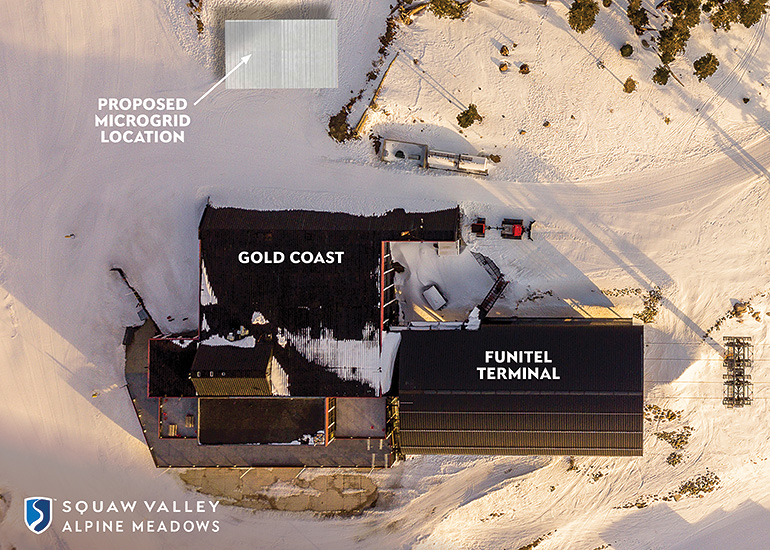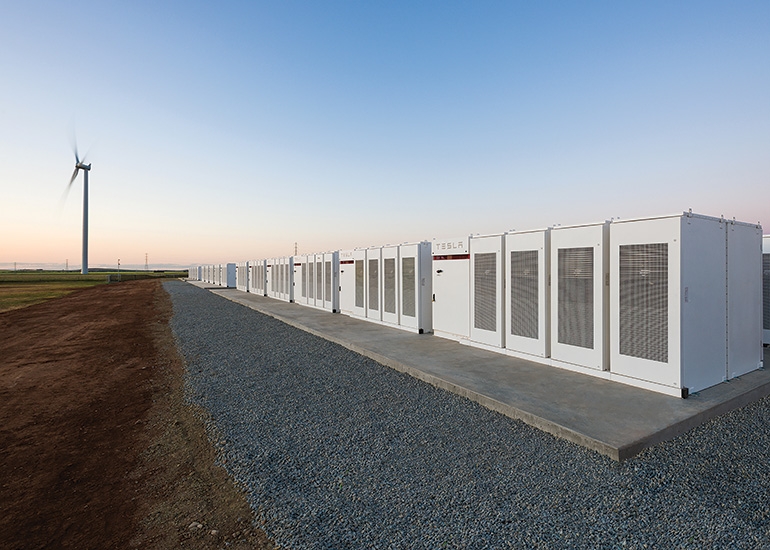Several months ago, Squaw Valley declared an ambitious goal: to become 100 percent powered via renewable energy by the end of this year. Not an easy task, but the resort is moving full speed ahead to meet its goal.
Squaw Valley’s push to the front edge of the energy transition has a powerful motivation: to avoid risk. A couple of blackouts in 2011 left skiers stranded on lifts at Squaw and adjoining Alpine Meadows. Andy Wirth, then Squaw’s chief executive, asked Liberty Utilities, the resort’s electrical supplier, what Squaw, as the largest private consumer of electricity among Liberty’s 49,000 customers in the Tahoe area, could do to minimize interruptions.
Wirth had a second and ultimately more pressing concern. About 20 percent of electricity delivered by Liberty to its Tahoe-Truckee customers came from a coal plant in Nevada. Could the utility shave the carbon from its generation portfolio and increase renewable energy? An important question, since climate change is a giant risk to skiing’s long-term future. It’s a hot-button issue at Squaw in particular, because the resort is home to Jeremy Jones, the big-mountain snowboarder who created the climate advocacy group Protect Our Winters, aka POW.
In March, shortly before he unexpectedly retired, Wirth stressed that his conversations with Liberty were “friendly and collaborative. We didn’t take a hammer approach.” But Squaw had clear goals. “The good news is that we had a partner,” he said.
Change has come in stages. In 2016, Liberty ceased getting coal-fired power from Nevada, and has now added two solar farms that together deliver 65 megawatts. This augments power from hydroelectric and geothermal sources.
The Powerwall Plan
As for those power interruptions, the solution is in the works. A plan for a backup power plant at Squaw Valley, called a microgrid, requires approval by both Placer County and the California Public Utilities Commission. No decision is expected until mid-way through 2019, though, according to Liberty representatives.
If those plans are approved, Liberty will house lithium-ion batteries at Gold Coast, the major mid-mountain center at Squaw. Tesla, whose Gigafactory 1 is 70 miles away, just east of Reno, Nev., is ready to supply the batteries, which will have capacity to store eight megawatts of electricity. That would be sufficient to provide electricity for four hours at Squaw and Alpine Meadows and the 900 businesses and residents of the Olympic Valley, as Squaw’s base area is called. It won’t be enough power to sustain snowmaking, but it will keep the lights on and the chairlifts turning.
 Liberty Utilities plans to house the microgrid at Squaw’s mid-mountain center at Gold Coast.
Liberty Utilities plans to house the microgrid at Squaw’s mid-mountain center at Gold Coast.
By 2019, Squaw Valley and Alpine Meadows hope they can claim to be 100 percent powered by renewable sources. It will be an asterisked claim; not all of the electrons in the batteries will necessarily come from renewables. But Liberty hopes to offer customers green tariffs, a form of renewable energy certificates, at an added cost of 1.8 cents per kilowatt hour (kWh). The tariffs will entitle customers to claim the exclusive use of a portion of Liberty’s renewable portfolio.
The Rise of Renewables
Squaw’s story provides a glimpse into the future. Renewable energy prices have been tumbling, in many cases undercutting conventional fossil fuel sources. Renewable “fuels” are free, unlike coal and gas, although far less predictable. Even so, by dispatching electrons to disparate markets, engineers have been able to deepen the renewable portfolios. Xcel Energy, which provides power to several of Colorado’s ski areas, is pushing toward 55 percent renewables in its portfolio by 2025. Company personnel say it would be possible to get to 70 percent. The National Renewable Energy Laboratory (NREL) says 80 percent is possible given existing technology.
Change rarely occurs without provocation. Xcel was pushed by successively higher renewable energy mandates in Colorado, delivered first by voters and then legislators. California legislators, in laws passed in 2013 and amended in 2016, are helping drive a brisk reduction in the price of batteries. The state’s three largest utilities are required to provide 1,825 megawatts of storage. Massachusetts in 2017 adopted a 200-megawatt mandate.
All that is made feasible by a drop in the cost of energy storage. Battery prices fell as much as 32 percent a year for several years, and now are declining by about 8 percent annually. A March report by GTM Research predicts continued declines of about 8 percent annually through 2022. Two key federal tax incentives—the investment tax credit and the modified accelerated cost recovery system—have encouraged adoption of energy storage systems such as batteries.
The renewable market is likely to continue to grow. Solar-plus-storage projects could be competitive without federal tax incentives in California by 2020, according to Paul Denholm, senior policy energy analyst at NREL. He told Utility Divide in May that solar-plus-storage could soon be competitive with gas-fired peaking plants in other locations, including the Southwest. Much depends upon the fluctuations in the cost of natural gas.
Forbes last year predicted that a $250 billion battery manufacturing industry was in the making. Tesla aims to be part of that with its manufacture of lithium-ion batteries. Its largest factory, the 4-million-square-foot Gigafactory 1, is easily spotted in the desert landscape while flying into the Reno-Tahoe International Airport.
“And it’s only 35 percent done. It’s absolutely the best example, the poster child, for scaling,” said Wirth.
Thinking Big
When the Squaw project was announced in February, JB Sraubel, Tesla’s chief technology officer and a member of its founding team, said Tesla has much bigger ambitions than just transportation.
“Tesla’s mission is to get us [the world] to 100 percent renewable energy as fast as possible,” he said in the webcast press conference. Tesla began its energy storage initiative seven or eight years ago. “We just saw it as an inevitable part of the future as everything progressed toward more and more renewable energy,” he said.
“Inherently, storage and renewable energy are linked,” he added. “You can’t get to 100 percent renewable energy without having a way to firm that output, to ensure you have that reliability in the process, so you can manage the grid and manage the loads. That’s why we have invested so much in the Gigafactory.”
But if renewable generation is a goal, the Powerpacks being manufactured at Tesla’s Gigafactory 1 can also help utilities save money, by avoiding transmission lines and excess generation capacity—all while making the grid more stable and robust. The key, Sraubel added, was to put the storage in the right places. Squaw Valley, he said, is the perfect example of that.
David Pasieka, chief operating officer of Liberty Utilities, also identifies battery storage as the “key element to making the transition to clean energy.” Growing up in Southern California, when the outdoor air was too filthy for healthy breathing, he remembers thinking somebody should do something. “Well, I’m here on a panel with people and companies that are doing something about it today.”
Change or Perish
The bigger issue is that of climate change. Climate scientists have consistently said that greenhouse gas emissions must be slowed or even reversed. From 280 parts per million (ppm) at the start of the industrial revolution, the levels of carbon dioxide (CO2) crept upward to about 315 ppm by the 1950s. Since then, CO2 levels have soared, topping 400 ppm just two or three years ago.
Is it too late to preserve the climate in which the modern ski industry was created? Probably. Scientists predict continued warming even if the global civilization can miraculously end the practices that have created the outsized greenhouse effect. Some prominent scientists urge finding ways to reduce greenhouse gases through geoengineering, but that’s unproven and possibly risky.
“It’s a little bit frustrating that we might be a generation or two on the wrong side of climate change,” Wirth said. “Of course, climate change is absolutely real. It’s an existential threat to our environment.” The challenge is to “actually get something done instead of just talking about it,” he says.
Major national action has a precedent; America’s waterways in the 1960s were badly polluted, but that has been turned around.
Climate change, he conceded, is a much bigger challenge. “But I would say this is just a question of will,” he says.






